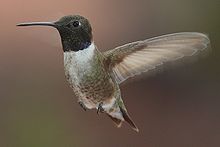|
Black-chinned hummingbird
The black-chinned hummingbird (Archilochus alexandri) is a hummingbird occupying a broad range of habitats.[3] Its summer range is in the western United States and southwestern Canada. It is migratory, wintering as far south as Mexico. In sunlight, the gorget of iridescent purple feathers bordering its black chin is noticeable. TaxonomyThe hybrid between the black-chinned hummingbird and Anna's hummingbird is called "Trochilus" violajugulum. The black-chinned hummingbird is also known to hybridize with Anna's,[4] Lucifer,[4] broad-tailed,[4] and Costa's hummingbirds.[5] As of 2011, it has the smallest known genome of all living amniotes, only 0.91 pg (910 million base pairs).[6] DescriptionThe black-chinned hummingbird is 8.25 cm (3.25 in) long. Adults are metallic green above and white below with green flanks. Their bill is long, straight and slender. The adult male has a black face and chin, a glossy purple gorget, and a dark forked tail. The female has a dark rounded tail with white tips and no throat patch. Juvenile plumage is similar to that of adult females, but with buff margins on the dorsal feathers. Juvenile males may also possess purple feathers on their throats.[7] Juveniles do not have a forked tail like adults.[8] Young are born almost featherless, but grow a complete set of feathers within three weeks of hatching.[9] Juveniles begin replacing their feathers in November after migrating for the winter. They have a completely new set of feathers before their first year of age.[9] Similar species to the black-chinned hummingbird include broad-tailed hummingbird, rufous hummingbird, calliope hummingbird, Allen's hummingbird, lucifer hummingbird, Anna's hummingbird, and Costa's hummingbird.[10] StatusThis species has been labeled as a least-concern species [1] because of its broad range (236,000 km2 (91,000 sq mi)), considerable population size and growth (14.6% increase per decade). Trend maps for black-chinned hummingbirds showed a relatively stable population between 2009 and 2019, albeit with some decline in late years of that decade.[11] VocalizationThe vocalization of the black-chinned hummingbird is a rapid, high-pitched chirp.[12][13] Distribution and habitatBlack-chinned hummingbirds are found in most of the western United States, reaching north into Canada in Alberta and British Columbia, east to Oklahoma, and as far south as Mexico.[3] They can be found in mountains, woodlands, orchards, meadows, and chaparral habitats. Their breeding habitat is open, semiarid areas, usually near water in the western United States, northern Mexico, and southern British Columbia. They may inhabit moist environments like orchards, shaded canyons, and riparian woods.[14] The males and females of this species use different habitats from one another for breeding territories.[15] Behavior and ecologyBreedingThis species uses diving displays (40–60 ft (12–18 m) dives) for territory defense and during courtship, producing an audible sound (a trill) as air passes through their feathers during the plunge.[16] In courtship, males perform "pendulum" display, flying back and forth in wide U-shaped arcs, making whirring sounds on each dive. They also buzz back and forth in short flights in front of perched females.[17] Black-chinned hummingbirds can exhibit territorial behavior around feeders as well as at other small feeding sites, becoming more defensive during breeding season. However, if there are numerous individuals in an area as well as multiple food sources, this species shows less territoriality.[18] FeedingThese birds feed on nectar from flowers using a long extendable tongue or catch insects on the wing. While collecting nectar, they also assist in plant pollination. NestingThe female builds a well-camouflaged nest in a protected location in a shrub or tree using plant fibers, spider web silk, downy feathers and lichens. Black-chinned hummingbirds prefer to nest 6–12 ft (1.8–3.7 m) above the ground, often on exposed horizontal branches below the canopy. Research also suggests that they may purposefully nest near the active nests of larger, predatory birds, as a means of reducing nest predation; the larger predators do not prey on the hummingbird, but their presence will deter other birds that might be interested in the black-chinned hummingbird's eggs or newly hatched chicks.[19] The female lays two white eggs at a time, each about 8 mm (0.31 in) in diameter, and may breed 2–3 times per year, incubating the eggs for 13–16 days. She feeds the young by inserting her bill deep into their throats and regurgitating insects and nectar. The young fledge at about 20–21 days.[17] Gallery
References
External linksWikimedia Commons has media related to Archilochus alexandri. Wikispecies has information related to Archilochus alexandri.
|
||||||||||||||||||||||||||||||||||||||||||||
Portal di Ensiklopedia Dunia






